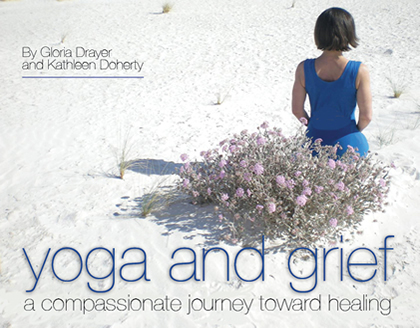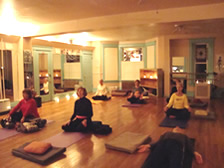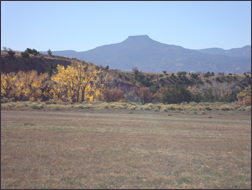
I wanted to share a new yoga resource with you. Gloria Drayer, a wonderful yoga teacher and friend, has co-written a book entitled, Yoga and Grief, a compassionate journey toward healing. This book is an insightful guide, explaining different yoga techniques and how they can support you as you experience and move through loss.
One of the first things I noticed about the book was the gentle, comforting language used. Nowhere do we hear what we must do to assuage our grief. Everywhere we are encouraged to use what works for us, to respect our own needs, to allow ourselves what time we need to heal, despite outside pressure to move on.
Most likely, the writers’ own experience and wisdom has guided their supportive tone. Both Gloria and Kathleen came to write this book out of their own experiences of loss: Gloria as she cared for her mother in her last year of life and Kathleen as she faced a major health crisis in her own life. Both talk about using the techniques of yoga described in this book to help them through their own journeys.
The writers explain that the suffering of loss unbalances our entire system. By using techniques of yoga we can rebalance the energy of our bodies and minds to find, over time, a sense of calm and peace.
This book is remarkable in its breadth, clarity, and accessibility. Strategies offered include breathing techniques, gentle yoga postures, meditation, chant, and the use of ritual. For each of these techniques, several options are offered for their use. For example, in the chapter on yoga postures, there is a practice that can be done in a chair, another done standing, another on the floor, a longer practice, as well as suggestions for rest, so that anyone can find something appropriate.
In each chapter, the writers explain the benefits of each technique and offer easy to follow instructions to perform it. To help follow instructions for yoga postures and breathing practices, clear black and white photos supplement the instructions, which are written accurately and simply. To support learning of the chant and meditation, Gloria has recordings of the chants and guided meditations given in the book on her two websites.
I highly recommend Yoga and Grief, a compassionate journey toward healing, whether you are dealing with grief right now or not. We all experience losses in our lives, be it the loss of a loved one, the death of a pet, the loss of health, the loss of a relationship, or a job or home, and most of us help others close to us with their losses. To understand the techniques of yoga and how they can support us can be invaluable when we need help. Gloria and Kathleen have created a remarkable resource. It is a gift to those needing a path through grief.
Visit www.YogaSimpleAndSacred.com or www.YogaAndGrief.com to learn how to order the printed book or e-book edition of Yoga and Grief, a compassionate journey toward healing.
 Can we ever really live detached from what we love deeply?
Can we ever really live detached from what we love deeply? If you had asked me what yoga was after my first year of taking weekly classes, most likely I would have said it was doing special poses so you felt good, relaxed and stronger, and were healthier. Later, after I had started reading a little about yoga, I might have added something like, “finding your true self” (whatever that was).
If you had asked me what yoga was after my first year of taking weekly classes, most likely I would have said it was doing special poses so you felt good, relaxed and stronger, and were healthier. Later, after I had started reading a little about yoga, I might have added something like, “finding your true self” (whatever that was). My last five blogs focused on the klesas or afflictions. Knowing what they are, being able to recognize them in our lives, and having tools to deal with them are key to a sense of peace in our lives. My certainty about this comes not just from the teachings I have received, but also from my own experience.
My last five blogs focused on the klesas or afflictions. Knowing what they are, being able to recognize them in our lives, and having tools to deal with them are key to a sense of peace in our lives. My certainty about this comes not just from the teachings I have received, but also from my own experience.  When I taught English Composition, students would come to me now and then to tell me they couldn’t write, or they hated writing. Their aversion to the course sometimes led them to avoid taking the class or dropping out or giving up, convinced they would fail no matter what. This decision had serious consequences. Without passing the required English classes, they could not receive an Associate Degree or transfer to a four year college.
When I taught English Composition, students would come to me now and then to tell me they couldn’t write, or they hated writing. Their aversion to the course sometimes led them to avoid taking the class or dropping out or giving up, convinced they would fail no matter what. This decision had serious consequences. Without passing the required English classes, they could not receive an Associate Degree or transfer to a four year college.  It is hard to give up a dream. But that is what my husband and I had to do. It started with our visits to Santa Fe, New Mexico. We enjoyed the landscape, the climate, the ambiance and everything about it. We decided to move there. It even became more of an obsession once our good friends moved there. We even had the house designed for the property we wanted, which would have made us neighbors of our friends. But it all fell through when we saw the cost and the reality that retirement was still a way off. Two more pieces of property became possibilities and both of those fell through for various reasons.
It is hard to give up a dream. But that is what my husband and I had to do. It started with our visits to Santa Fe, New Mexico. We enjoyed the landscape, the climate, the ambiance and everything about it. We decided to move there. It even became more of an obsession once our good friends moved there. We even had the house designed for the property we wanted, which would have made us neighbors of our friends. But it all fell through when we saw the cost and the reality that retirement was still a way off. Two more pieces of property became possibilities and both of those fell through for various reasons.  Check out last week’s blog –
Check out last week’s blog –